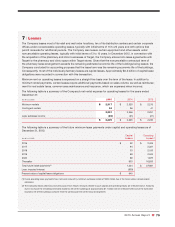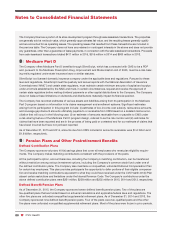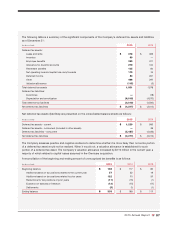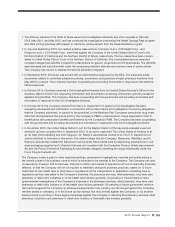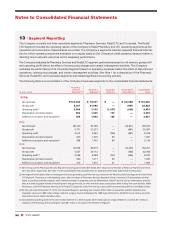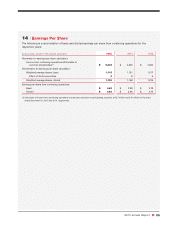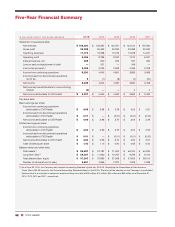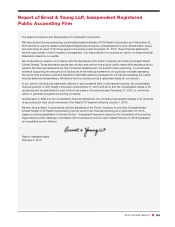CVS 2015 Annual Report Download - page 91
Download and view the complete annual report
Please find page 91 of the 2015 CVS annual report below. You can navigate through the pages in the report by either clicking on the pages listed below, or by using the keyword search tool below to find specific information within the annual report.
89
2015 Annual Report
Company evaluates, on a quarterly basis, developments in legal matters that could affect the amount of any accrual
and developments that would make a loss contingency both probable and reasonably estimable. If a loss contingency
is not both probable and estimable, the Company does not establish an accrued liability. None of the Company’s
accruals for outstanding legal matters are material individually or in the aggregate to the Company’s financial position.
The Company’s contingencies are subject to significant uncertainties, including, among other factors: (i) the proce-
dural status of pending matters; (ii) whether class action status is sought and certified; (iii) whether asserted claims
or allegations will survive dispositive motion practice; (iv) the extent of potential damages, fines or penalties, which
are often unspecified or indeterminate; (v) the impact of discovery on the legal process; (vi) whether novel or
unsettled legal theories are at issue; (vii) the settlement posture of the parties, and/or (viii) in the case of certain
government agency investigations, whether a sealed
qui tam
lawsuit (“whistleblower” action) has been filed and
whether the government agency makes a decision to intervene in the lawsuit following investigation.
Except as otherwise noted, the Company cannot predict with certainty the timing or outcome of the legal matters
described below, and is unable to reasonably estimate a possible loss or range of possible loss in excess of
amounts already accrued for these matters.
• Caremark (the term “Caremark” being used herein to generally refer to any one or more PBM subsidiaries of the
Company, as applicable) was named in a putative class action lawsuit filed in October 2003 in Alabama state
court by John Lauriello, purportedly on behalf of participants in the 1999 settlement of various securities class
action and derivative lawsuits against Caremark and others. Other defendants include insurance companies that
provided coverage to Caremark with respect to the settled lawsuits. The Lauriello lawsuit seeks approximately
$3.2 billion in compensatory damages plus other non-specified damages based on allegations that the amount of
insurance coverage available for the settled lawsuits was misrepresented and suppressed. A similar lawsuit was
filed in November 2003 by Frank McArthur, also in Alabama state court, naming as defendants, among others,
Caremark and several insurance companies involved in the 1999 settlement. This lawsuit was stayed as a
later-filed class action, but McArthur was subsequently allowed to intervene in the Lauriello action. Following the
close of class discovery, the trial court entered an Order on August 15, 2012 that granted the plaintiffs’ motion to
certify a class pursuant to Alabama Rule of Civil Procedures 23(b)(3) but denied their request that the class also
be certified pursuant to Rule 23(b)(1). In addition, the August 15, 2012 Order appointed class representatives and
class counsel. On September 12, 2014, the Alabama Supreme Court affirmed the trial court’s August 15, 2012
Order. In November 2015, the trial court ruled on the parties’ motions for summary judgment. The Court granted
in part and denied in part plaintiffs’ motion for summary judgment and the Court denied Caremark’s motion for
summary judgment. The parties engaged in mediation in January 2016. The case is proceeding and trial is
currently scheduled to begin on February 19, 2016.
• Beginning in August 2003, various lawsuits were filed by pharmacies alleging that Caremark and other PBMs were
violating certain antitrust laws. In August 2003, Bellevue Drug Co., Robert Schreiber, Inc. d/b/a Burns Pharmacy
and Rehn-Huerbinger Drug Co. d/b/a Parkway Drugs #4, together with Pharmacy Freedom Fund and the National
Community Pharmacists Association filed a putative class action against Caremark in the United States District
Court for the Eastern District of Pennsylvania, seeking treble damages and injunctive relief. This case was initially
sent to arbitration based on the contract terms between the pharmacies and Caremark, but later returned to
federal court, where it currently remains. In addition, in October 2003, two independent pharmacies, North
Jackson Pharmacy, Inc. and C&C, Inc. d/b/a Big C Discount Drugs, Inc., filed three separate putative class action
complaints in the United States District Court for the Northern District of Alabama, all seeking treble damages
and injunctive relief. One complaint named three Caremark entities as defendants, and the other two complaints
named PBM competitors. The North Jackson Pharmacy case against two of the Caremark entities was transferred
to the United States District Court for the Northern District of Illinois; the case against the third Caremark entity
was sent to arbitration based on contract terms between the pharmacies and that entity. The arbitration was
stayed at the parties’ request and later closed by the American Arbitration Association.


